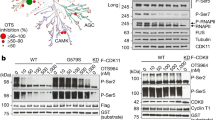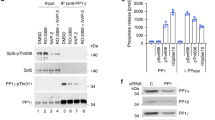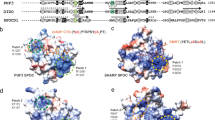Abstract
The synthesis of pre-mRNA by RNA polymerase II (Pol II) involves the formation of a transcription initiation complex, and a transition to an elongation complex1,2,3,4. The large subunit of Pol II contains an intrinsically disordered C-terminal domain that is phosphorylated by cyclin-dependent kinases during the transition from initiation to elongation, thus influencing the interaction of the C-terminal domain with different components of the initiation or the RNA-splicing apparatus5,6. Recent observations suggest that this model provides only a partial picture of the effects of phosphorylation of the C-terminal domain7,8,9,10,11,12. Both the transcription-initiation machinery and the splicing machinery can form phase-separated condensates that contain large numbers of component molecules: hundreds of molecules of Pol II and mediator are concentrated in condensates at super-enhancers7,8, and large numbers of splicing factors are concentrated in nuclear speckles, some of which occur at highly active transcription sites9,10,11,12. Here we investigate whether the phosphorylation of the Pol II C-terminal domain regulates the incorporation of Pol II into phase-separated condensates that are associated with transcription initiation and splicing. We find that the hypophosphorylated C-terminal domain of Pol II is incorporated into mediator condensates and that phosphorylation by regulatory cyclin-dependent kinases reduces this incorporation. We also find that the hyperphosphorylated C-terminal domain is preferentially incorporated into condensates that are formed by splicing factors. These results suggest that phosphorylation of the Pol II C-terminal domain drives an exchange from condensates that are involved in transcription initiation to those that are involved in RNA processing, and implicates phosphorylation as a mechanism that regulates condensate preference.
This is a preview of subscription content, access via your institution
Access options
Access Nature and 54 other Nature Portfolio journals
Get Nature+, our best-value online-access subscription
$29.99 / 30 days
cancel any time
Subscribe to this journal
Receive 51 print issues and online access
$199.00 per year
only $3.90 per issue
Buy this article
- Purchase on Springer Link
- Instant access to full article PDF
Prices may be subject to local taxes which are calculated during checkout




Similar content being viewed by others
Code availability
All custom code used in this study is available upon request.
References
Adelman, K. & Lis, J. T. Promoter-proximal pausing of RNA polymerase II: emerging roles in metazoans. Nat. Rev. Genet. 13, 720–731 (2012).
Harlen, K. M. & Churchman, L. S. The code and beyond: transcription regulation by the RNA polymerase II carboxy-terminal domain. Nat. Rev. Mol. Cell Biol. 18, 263–273 (2017).
Levine, M., Cattoglio, C. & Tjian, R. Looping back to leap forward: transcription enters a new era. Cell 157, 13–25 (2014).
Sainsbury, S., Bernecky, C. & Cramer, P. Structural basis of transcription initiation by RNA polymerase II. Nat. Rev. Mol. Cell Biol. 16, 129–143 (2015).
Eick, D. & Geyer, M. The RNA polymerase II carboxy-terminal domain (CTD) code. Chem. Rev. 113, 8456–8490 (2013).
Ebmeier, C. C. et al. Human TFIIH kinase CDK7 regulates transcription-associated chromatin modifications. Cell Reports 20, 1173–1186 (2017).
Cho, W. K. et al. Mediator and RNA polymerase II clusters associate in transcription-dependent condensates. Science 361, 412–415 (2018).
Sabari, B. R. et al. Coactivator condensation at super-enhancers links phase separation and gene control. Science 361, eaar3958 (2018).
Spector, D. L. & Lamond, A. I. Nuclear speckles. Cold Spring Harb. Perspect. Biol. 3, a000646 (2011).
Chen, Y. et al. Mapping 3D genome organization relative to nuclear compartments using TSA-seq as a cytological ruler. J. Cell Biol. 217, 4025–4048 (2018).
Quinodoz, S. A. et al. Higher-order inter-chromosomal hubs shape 3D genome organization in the nucleus. Cell 174, 744–757 (2018).
Hall, L. L., Smith, K. P., Byron, M. & Lawrence, J. B. Molecular anatomy of a speckle. Anat. Rec. A Discov. Mol. Cell. Evol. Biol. 288A, 664–675 (2006).
Allen, B. L. & Taatjes, D. J. The Mediator complex: a central integrator of transcription. Nat. Rev. Mol. Cell Biol. 16, 155–166 (2015).
Boija, A. et al. Transcription factors activate genes through the phase-separation capacity of their activation domains. Cell 175, 1842–1855 (2018).
Zhang, X. et al. MED1/TRAP220 exists predominantly in a TRAP/Mediator subpopulation enriched in RNA polymerase II and is required for ER-mediated transcription. Mol. Cell 19, 89–100 (2005).
Banani, S. F., Lee, H. O., Hyman, A. A. & Rosen, M. K. Biomolecular condensates: organizers of cellular biochemistry. Nat. Rev. Mol. Cell Biol. 18, 285–298 (2017).
Hnisz, D., Shrinivas, K., Young, R. A., Chakraborty, A. K. & Sharp, P. A. A phase separation model for transcriptional control. Cell 169, 13–23 (2017).
Shin, Y. & Brangwynne, C. P. Liquid phase condensation in cell physiology and disease. Science 357, eaaf4382 (2017).
Hnisz, D. et al. Super-enhancers in the control of cell identity and disease. Cell 155, 934–947 (2013).
Braunschweig, U., Gueroussov, S., Plocik, A. M., Graveley, B. R. & Blencowe, B. J. Dynamic integration of splicing within gene regulatory pathways. Cell 152, 1252–1269 (2013).
Herzel, L., Ottoz, D. S. M., Alpert, T. & Neugebauer, K. M. Splicing and transcription touch base: co-transcriptional spliceosome assembly and function. Nat. Rev. Mol. Cell Biol. 18, 637–650 (2017).
Hsin, J. P. & Manley, J. L. The RNA polymerase II CTD coordinates transcription and RNA processing. Genes Dev. 26, 2119–2137 (2012).
Kotake, Y. et al. Splicing factor SF3b as a target of the antitumor natural product pladienolide. Nat. Chem. Biol. 3, 570–575 (2007).
Akhtar, M. S. et al. TFIIH kinase places bivalent marks on the carboxy-terminal domain of RNA polymerase II. Mol. Cell 34, 387–393 (2009).
Czudnochowski, N., Bösken, C. A. & Geyer, M. Serine-7 but not serine-5 phosphorylation primes RNA polymerase II CTD for P-TEFb recognition. Nat. Commun. 3, 842 (2012).
Kwon, I. et al. Phosphorylation-regulated binding of RNA polymerase II to fibrous polymers of low-complexity domains. Cell 155, 1049–1060 (2013).
Long, J. C. & Caceres, J. F. The SR protein family of splicing factors: master regulators of gene expression. Biochem. J. 417, 15–27 (2009).
McCracken, S. et al. The C-terminal domain of RNA polymerase II couples mRNA processing to transcription. Nature 385, 357–361 (1997).
Boehning, M. et al. RNA polymerase II clustering through carboxy-terminal domain phase separation. Nat. Struct. Mol. Biol. 25, 833–840 (2018).
Lu, H. et al. Phase-separation mechanism for C-terminal hyperphosphorylation of RNA polymerase II. Nature 558, 318–323 (2018).
Bolte, S. & Cordelières, F. P. A guided tour into subcellular colocalization analysis in light microscopy. J. Microsc. 224, 213–232 (2006).
Meyer, K. D. et al. Cooperative activity of cdk8 and GCN5L within Mediator directs tandem phosphoacetylation of histone H3. EMBO J. 27, 1447–1457 (2008).
Shen, L., Shao, N., Liu, X. & Nestler, E. ngs.plot: quick mining and visualization of next-generation sequencing data by integrating genomic databases. BMC Genomics 15, 284 (2014).
Grimm, J. B. et al. A general method to improve fluorophores for live-cell and single-molecule microscopy. Nat. Methods 12, 244–250 (2015).
Lambert, T. & Shao, L. tlambert03/LLSpy v.0.3.8. https://zenodo.org/record/1204615#.XTB-miJKhaQ (2018).
Sergé, A., Bertaux, N., Rigneault, H. & Marguet, D. Dynamic multiple-target tracing to probe spatiotemporal cartography of cell membranes. Nat. Methods 5, 687–694 (2008).
Verdaasdonk, J. S., Lawrimore, J. & Bloom, K. Determining absolute protein numbers by quantitative fluorescence microscopy. Methods Cell Biol. 123, 347–365 (2014).
Younis, I. et al. Rapid-response splicing reporter screens identify differential regulators of constitutive and alternative splicing. Mol. Cell. Biol. 30, 1718–1728 (2010).
Banani, S. F. et al. Compositional control of phase-separated cellular bodies. Cell 166, 651–663 (2016).
Wang, J. et al. A molecular grammar governing the driving forces for phase separation of prion-like RNA binding proteins. Cell 174, 688–699 (2018).
Acknowledgements
We thank I. A. Klein, J. Schuijers, C. H. Li, E. L. Coffey and other members in the Young laboratory for helpful discussions, W. Salmon of the W. M. Keck Microscopy Facility, T. Volkert, J. Love and S. Gupta of the Whitehead Genomics Core facility for technical assistance, M. Stubna for help with droplet and biochemical assays and S. L. McKnight, I. Kwon and M. Kato for CTD constructs. The work was supported by NIH grant GM123511 (R.A.Y.), NSF grant PHY1743900 (R.A.Y. and P.A.S.), NIH GM117370 and GM110064 (D.J.T.), NIH grant R01-GM034277 (P.A.S.), Cancer Research Institute Irvington Fellowship (Y.E.G.), Damon Runyon Cancer Research Foundation Fellowship (2309-17) (B.R.S.), Hope Funds for Cancer Research fellowship (B.J.A.), Swedish Research Council Postdoctoral Fellowship (VR 2017-00372) (A.B.), the German Research Foundation DFG Postdoctoral Fellowship SP 1680/1-1 (J.-H.S.), DE 3069/1-1 (T.-M.D.), NIH T32 GM008759 (C.B.F.) and funds from Novo Nordisk (R.A.Y. and P.A.S.).
Author information
Authors and Affiliations
Contributions
Y.E.G. and R.A.Y. conceived the project. Y.E.G., J.C.M. and R.A.Y. organized the studies and wrote the manuscript. Y.E.G. and B.R.S. performed in vitro droplet formation assays. J.C.M., A.D. and A.B. performed immunofluorescence experiments. J.E.H. and K.S. developed and performed computational analyses. B.R.S., Y.E.G, B.J.A. and J.C.M. performed ChIP and analysed data. N.M.H. purified recombinant proteins. Y.E.G., J.E.H. and L.K.A. generated cell lines. J.-H.S. and A.V.Z. performed lattice light-sheet microscopy and analysis. T.-M.D., J.K.R., C.B.F. and D.J.T. purified human mediator. Y.E.G., J.C.M. and J.E.H. generated constructs. J.E.H. performed live cell imaging. J.E.H. and T.I.L. contributed to writing the manuscript. P.A.S. and I.I.C. provided input into experimental design and interpretation. R.A.Y. supervised the project with the help from T.I.L. All authors contributed to editing the manuscript.
Corresponding author
Ethics declarations
Competing interests
R.A.Y. is a founder and shareholder of Syros Pharmaceuticals, Camp4 Therapeutics, Omega Therapeutics and Dewpoint Therapeutics. P.A.S. is a member of the board and shareholder in Syros and a member of the Scientific Advisory Board of Dewpoint. B.J.A. and T.I.L. are shareholders of Syros Pharmaceuticals. T.I.L. is a consultant to Camp4 Therapeutics and I.I.C. is a consultant to Dewpoint Therapeutics. All other authors declare no competing interests.
Additional information
Publisher’s note: Springer Nature remains neutral with regard to jurisdictional claims in published maps and institutional affiliations.
Extended data figures and tables
Extended Data Fig. 1 CTD partitioning in mediator condensates.
a, Average immunofluorescence signal for MED1 and Pol II centred on randomly selected nuclear positions. b, Images of a fusion event between two full-length CTD–MED1-IDR droplets. GFP–CTD52 at 10 μM was mixed with 10μM mCherry–MED1-IDR in droplet-formation buffer with 125 mM NaCl and 16% Ficoll-400. c, Top, representative images of FRAP of heterotypic droplets of mCherry–MED1-IDR and GFP–CTD52. Droplet-formation conditions are the same as in b. Bottom, quantification of the fraction of FRAP of mCherry–MED1-IDR and GFP–CTD52. Data are mean ± s.d. (n = 3 experiments).
Extended Data Fig. 2 Splicing factors at Trim28, and quantification of SRSF2 and Pol II molecules.
a, Representative images exhibiting overlap between immunofluorescence of splicing factors SRSF2, SF3B1, U2AF2, HNRNPA1, SRSF1, SRRM1, PRPF8, or SNRNP70 with nascent RNA FISH of Trim28 in fixed mouse ES cells. b, Left, histogram of the integrated intensity of single Halo–JF646 (n = 178) and single GFP emitters (n = 177). Mean values of 164.8 ± 5.6 counts (mean ± s.e.m.) and 108.6 ± 5.1 counts (mean ± s.e.m.) were used to normalize the integrated intensity of Pol II–Halo–JF646 and SRSF2–GFP, respectively. Right, scatter plot depicting the estimated numbers of Pol II and SRSF2 molecules in colocalizing Pol II and SRSF2 puncta (see Methods).
Extended Data Fig. 3 Splicing inhibition and splicing-factor condensates.
a, Left, diagram depicting the splicing reporter used to measure splicing inhibition after treatment with pladienolide B. Right, relative levels of splicing in cells treated with DMSO versus cells treated with pladienolide B for 4 h. The mean of three biological replicates (each replicate shown as dot) with s.d. is plotted (see Methods). b, Representative images exhibiting overlap or absence of overlap between immunofluorescence of SF3B1 or Pol II and DNA FISH of Trim28 in mouse ES cells treated with either DMSO or pladienolide B for 4 h. c, Fraction of overlap of FISH foci with immunofluorescence puncta in cells treated with pladienolide B relative to cells treated with DMSO. The asterisk above the drug-treated bar indicates *P < 0.05 from a two-tailed χ2 test comparing the number of overlapping and non-overlapping FISH spots in the DMSO versus the drug condition (see Methods).
Extended Data Fig. 4 Liquid-like properties of SRSF2 condensates.
a, Live-cell imaging of GFP–SRSF2 mouse ES cells. Ten independent fields from one plate of cells were imaged. b, Representative images of FRAP experiments performed on the GFP–SRSF2 mouse ES cell line. c, Quantification of experiment depicted in b. Data are mean ± s.d. (n = 9 experiments). d, Representative images of live cells before and after treatment with 10% 1,6-hexanediol for approximately 17 min. Five independent fields from one plate of cells were imaged before and after treatment. e, Examples of fusion events occurring between SRSF2 puncta in the GFP–SRSF2 cell line. Two fields from two independent plates of cells were imaged over a two-hour time course, and each showed at least one fusion event.
Extended Data Fig. 5 Effects of treatment with DRB on splicing-factor and transcriptional condensates.
a, Representative images exhibiting overlap or lack of overlap between immunofluorescence of SRSF2 and DNA FISH of Trim28 in mouse ES cells treated with DMSO for 2 h, DRB for 2 h, or DRB for 2 h followed by a 2-h DRB washout. b, Representative images exhibiting overlap between immunofluorescence of MED1 and DNA FISH of Trim28 in mouse ES cells treated with DMSO for 2 h, DRB for 2 h, or DRB for 2 h followed by a 2-h DRB washout. c, Representative images exhibiting overlap between immunofluorescence of Pol II and DNA FISH of Nanog or Trim28 in mouse ES cells treated with DMSO for 2 h, DRB for 2 h, or DRB for 2 h followed by a 2-h DRB washout. d, Fraction of overlap of FISH foci with immunofluorescence puncta in cells treated with DRB or DRB followed by washout, relative to cells treated with DMSO. The asterisk above the DRB-treated bar indicates *P < 0.05 from a two-tailed χ2 test comparing the number of overlapping and non-overlapping FISH spots in the DMSO versus DRB condition. The asterisk over the washout bar indicates *P < 0.05 from a two-tailed χ2 test comparing the DRB versus washout condition. The splicing factors that we tested showed a significantly decreased, or trended towards a decreased, overlap with FISH spots in the DRB condition compared to DMSO, whereas MED1 and Pol II exhibited limited changes (see Methods).
Extended Data Fig. 6 Phosphorylation of Pol II CTD in vitro, and CTD partitioning in MED1-IDR droplets.
a, Western blot showing phosphorylation of Pol II CTD by CDK7. Equal amounts of non-phosphorylated and phosphorylated GFP–CTD52 (see Methods) were run on a 3–8% SDS–PAGE gel, and analysed by western blot using anti-GFP antibodies. Similar results were obtained in two biological replicates. For gel source data, see Supplementary Fig. 1. b, Western blot showing phosphorylation of Pol II CTD by CDK9. Similar results were obtained in two biological replicates. For gel source data, see Supplementary Fig. 1. c, Representative images of droplet experiments that measured incorporation of Pol II CTD into MED1-IDR droplets. Purified mCherry–MED1-IDR at 10 μM was mixed with 3.3 μM GFP, GFP–CTD52 or GFP–CTD52 phosphorylated with CDK7 or CDK9 in droplet-formation buffers with 125 mM NaCl and 16% Ficoll-400 or 10% PEG-8000. d, Partition ratios of GFP and GFP–CTD in MED1-IDR droplets, and partition ratios of mCherry–MED1-IDR from experiments depicted in c.
Extended Data Fig. 7 Splicing factors form droplets in vitro.
a, Representative images of droplet formation by mCherry (mCh)–SRSF2, mCherry–SRSF1, mCherry–U2AF2 and mCherry–HNRNPA1 with increasing protein concentrations. All assays were performed in the presence of 120 mM NaCl and 10% PEG-8000. b, Quantification of the partition ratios from the experiments depicted in a. c, Representative images of heterotypic droplets formed between SRSF2 and other splicing factors, including SRSF1, U2AF2 and HNRNPA1. Purified human SRSF2 fused to GFP (GFP–SRSF2) at 2.5 μM was mixed with 2.5 μM purified mCherry–SRSF2, mCherry–SRSF1, mCherry–U2AF2 or mCherry–HNRNPA1 in droplet-formation buffers with 120 mM NaCl and 10% PEG-8000.
Extended Data Fig. 8 CTD partitioning in SR-protein droplets.
a, Quantification of the partition ratios of SRSF2 from experiments depicted in Fig. 4b. b, Quantification of the partition ratios of SRSF1 from experiments depicted in Fig. 4c. c, Representative images and quantification of partition ratios of droplet experiments that measured the incorporation of Pol II CTD into SRSF2 droplets. The same reagents and conditions were used as in Fig. 4b, except that 16% Ficoll-400 was used as a crowding agent. d, Representative images and quantification of partition ratios of droplet experiments that measured the incorporation of phosphorylated full-length or truncated Pol II CTD into SRSF2 droplets. The droplet-formation conditions are the same as described in Fig. 4b.
Supplementary information
Supplementary Information
This file contains Supplementary Figure 1: Uncropped western blots with size markers.
Rights and permissions
About this article
Cite this article
Guo, Y.E., Manteiga, J.C., Henninger, J.E. et al. Pol II phosphorylation regulates a switch between transcriptional and splicing condensates. Nature 572, 543–548 (2019). https://doi.org/10.1038/s41586-019-1464-0
Received:
Accepted:
Published:
Issue Date:
DOI: https://doi.org/10.1038/s41586-019-1464-0
This article is cited by
-
The molecular basis for cellular function of intrinsically disordered protein regions
Nature Reviews Molecular Cell Biology (2024)
-
Transcriptional condensates: a blessing or a curse for gene regulation?
Communications Biology (2024)
-
Machine learning predictor PSPire screens for phase-separating proteins lacking intrinsically disordered regions
Nature Communications (2024)
-
Disordered C-terminal domain drives spatiotemporal confinement of RNAPII to enhance search for chromatin targets
Nature Cell Biology (2024)
-
Biomolecular condensates create phospholipid-enriched microenvironments
Nature Chemical Biology (2024)
Comments
By submitting a comment you agree to abide by our Terms and Community Guidelines. If you find something abusive or that does not comply with our terms or guidelines please flag it as inappropriate.



